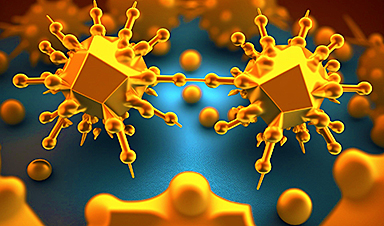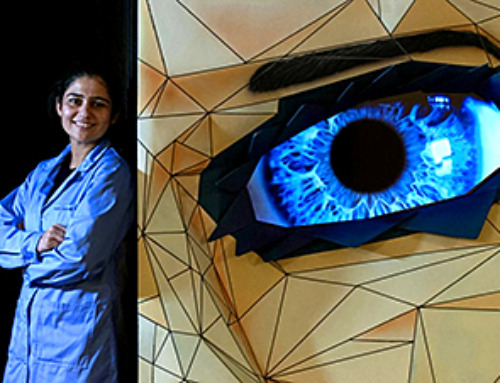Tiny nanoparticles are at the forefront of materials science—with special properties that make them great at absorbing light in solar panels, cleaning wastewater, and delivering drugs precisely.
Some nanoparticles take the form of sheets or fibers. But nanomaterials all have one thing in common—their structure contains components with dimensions on the nanometer scale. That’s more than 10,000 times smaller than the width of a human hair. Research shows that nanomaterials often perform better than the same materials made on a larger scale. They have huge potential, but currently their manufacture can result in harmful environmental effects due to the use or production of hazardous chemicals.
I’m one of many researchers studying how to create, manipulate and apply these materials sustainably to develop new technologies and improve existing ones. This offers advantages across many applications, including aerospace, solar panels and electronics.
Silica nanomaterial is already all around you, but you probably don’t even realize it. Silica (SiO2), a compound that contains both silicon and oxygen, is commonly found in rocks. It is one of the most mass produced nanomaterials worldwide, with an expected market of US$5 trillion (£3.8 trillion) by 2025.
It’s used to make things you encounter every day, from improving the strength of concrete to improving the durability of rubber tires, plus it enhances the cleaning properties and consistency of toothpaste. Silica nanomaterial could have exciting high-value applications, like medicines and wastewater treatment.
While silica products might be great, the way they are made is often not great for the environment, or even economically feasible. Manufacturing is key to overall product sustainability, but it’s often invisible to consumers. As such, it’s an aspect that most people consider far less than, for example, whether something will be recycled.
Making silica often requires energy-intensive processes, or makes nasty waste products that are difficult to safely dispose of. Trying to reduce the environmental footprint of existing processes is not enough. Developing new production methods is paramount to ensuring that new technologies, such as more advanced solar panels, can both help society and have less impact on the environment than traditional manufacturing.
I am part of the Green Nanomaterials Research Group at the University of Sheffield, where my colleagues and I are working hard to develop sustainable, scalable and economical routes to functional nanostructured materials. We address aspects from discovery to manufacturing, applications and commercialization, considering the performance, scalability, environment and cost.
A greener approach to chemistry
We aim to make better nanomaterials for important applications, while considering the environmental impact at every stage of a nanomaterial’s life, from raw materials through to the use and disposal of a product and any by-products. This approach is known as “green chemistry,” a concept developed in 1998 that has been used to develop strategies for greener routes to nanomaterials.
Silica nanomaterial suits this green chemistry approach because it is already made in nature by plants and sponges as structural support. What better teacher for green chemistry than to learn from nature itself? My research group created bio-inspired silica, a product that can be made at room temperature, and in the mild conditions under which silica is made naturally in biology.
Now, colleagues in my research group are scaling up bio-inspired silica production, exploring its use in different applications and making different nanomaterials. Meanwhile, I’m exploring how changing the conditions under which we make silica can improve the properties, like surface area, that make it function better.
There’s huge scope for green nanomaterials to advance essential technologies, and if green silica could be scaled up, the potential for substantial change to drug delivery and renewables is vast.
Provided by The Conversation
News
Breakthrough Drug Restores Vision: Researchers Successfully Reverse Retinal Damage
Blocking the PROX1 protein allowed KAIST researchers to regenerate damaged retinas and restore vision in mice. Vision is one of the most important human senses, yet more than 300 million people around the world are at [...]
Differentiating cancerous and healthy cells through motion analysis
Researchers from Tokyo Metropolitan University have found that the motion of unlabeled cells can be used to tell whether they are cancerous or healthy. They observed malignant fibrosarcoma cells and [...]
This Tiny Cellular Gate Could Be the Key to Curing Cancer – And Regrowing Hair
After more than five decades of mystery, scientists have finally unveiled the detailed structure and function of a long-theorized molecular machine in our mitochondria — the mitochondrial pyruvate carrier. This microscopic gatekeeper controls how [...]
Unlocking Vision’s Secrets: Researchers Reveal 3D Structure of Key Eye Protein
Researchers have uncovered the 3D structure of RBP3, a key protein in vision, revealing how it transports retinoids and fatty acids and how its dysfunction may lead to retinal diseases. Proteins play a critical [...]
5 Key Facts About Nanoplastics and How They Affect the Human Body
Nanoplastics are typically defined as plastic particles smaller than 1000 nanometers. These particles are increasingly being detected in human tissues: they can bypass biological barriers, accumulate in organs, and may influence health in ways [...]
Measles Is Back: Doctors Warn of Dangerous Surge Across the U.S.
Parents are encouraged to contact their pediatrician if their child has been exposed to measles or is showing symptoms. Pediatric infectious disease experts are emphasizing the critical importance of measles vaccination, as the highly [...]
AI at the Speed of Light: How Silicon Photonics Are Reinventing Hardware
A cutting-edge AI acceleration platform powered by light rather than electricity could revolutionize how AI is trained and deployed. Using photonic integrated circuits made from advanced III-V semiconductors, researchers have developed a system that vastly [...]
A Grain of Brain, 523 Million Synapses, Most Complicated Neuroscience Experiment Ever Attempted
A team of over 150 scientists has achieved what once seemed impossible: a complete wiring and activity map of a tiny section of a mammalian brain. This feat, part of the MICrONS Project, rivals [...]
The Secret “Radar” Bacteria Use To Outsmart Their Enemies
A chemical radar allows bacteria to sense and eliminate predators. Investigating how microorganisms communicate deepens our understanding of the complex ecological interactions that shape our environment is an area of key focus for the [...]
Psychologists explore ethical issues associated with human-AI relationships
It's becoming increasingly commonplace for people to develop intimate, long-term relationships with artificial intelligence (AI) technologies. At their extreme, people have "married" their AI companions in non-legally binding ceremonies, and at least two people [...]
When You Lose Weight, Where Does It Actually Go?
Most health professionals lack a clear understanding of how body fat is lost, often subscribing to misconceptions like fat converting to energy or muscle. The truth is, fat is actually broken down into carbon [...]
How Everyday Plastics Quietly Turn Into DNA-Damaging Nanoparticles
The same unique structure that makes plastic so versatile also makes it susceptible to breaking down into harmful micro- and nanoscale particles. The world is saturated with trillions of microscopic and nanoscopic plastic particles, some smaller [...]
AI Outperforms Physicians in Real-World Urgent Care Decisions, Study Finds
The study, conducted at the virtual urgent care clinic Cedars-Sinai Connect in LA, compared recommendations given in about 500 visits of adult patients with relatively common symptoms – respiratory, urinary, eye, vaginal and dental. [...]
Challenging the Big Bang: A Multi-Singularity Origin for the Universe
In a study published in the journal Classical and Quantum Gravity, Dr. Richard Lieu, a physics professor at The University of Alabama in Huntsville (UAH), which is a part of The University of Alabama System, suggests that [...]
New drug restores vision by regenerating retinal nerves
Vision is one of the most crucial human senses, yet over 300 million people worldwide are at risk of vision loss due to various retinal diseases. While recent advancements in retinal disease treatments have [...]
Shingles vaccine cuts dementia risk by 20%, new study shows
A shingles shot may do more than prevent rash — it could help shield the aging brain from dementia, according to a landmark study using real-world data from the UK. A routine vaccine could [...]





















